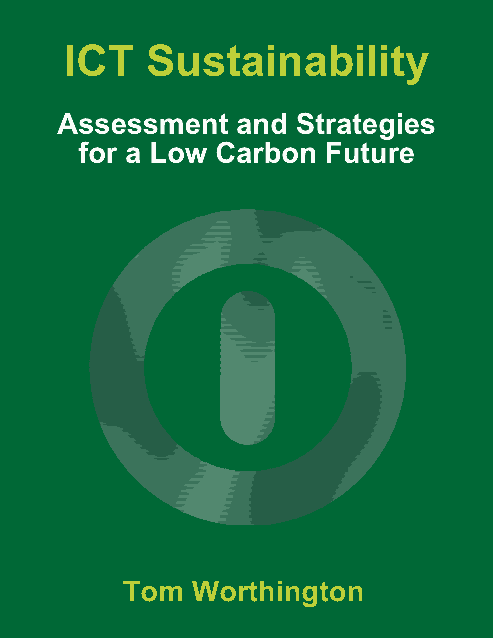From the book: Green Technology Strategies
Enabling ICT
ICT systems can reduce energy and materials use by improving the efficiency of business systems by replacing the movement of goods with information (dematerialisation), improve the efficiency of machines (smart motor systems), logistics, buildings and grids.
Dematerialisation
Dematerialisation substitutes low carbon alternatives for high carbon products and services. Typical examples are replacing travelling to meetings with teleworking via computer and videoconferencing. Paper invoices can be replaced with electronic ones, reducing the use of paper and the energy needed to transport the paper.
However it cannot be assumed that every ICT system will result in a smaller energy use or that users will use the systems as expected. A server for e-commence may use more energy than the paper it is replacing. Teleworking may stimulate more face-to-face meetings for participants, rather than displace them.
SMART motor systems
Electric motors used in industry contribute a significant proportion of carbon emissions. Computer controlled variable-speed drives (VSD) can be used to reduce the power provided by the motor to the requirements of the task, thus saving energy and reducing emissions.
SMART logistics
Logistics is the study of the management of the flow of goods from the point of production to consumption. Logistics was an early adopter of ICT systems. New techniques use Radio frequency identification (RFID) tags to individually track items of inventory, Geographical information systems (GIS) to plan deliveries and Global Positioning Systems (GPS) for Real time fleet tracking.
SMART buildings
Building Automation Systems (BAS) use a network of sensors to monitor conditions in a building and adjust the mechanical and lighting systems to minimise energy use using techniques such as Occupancy-based lighting and Demand control ventilation. The term 'smart buildings' is used more broadly to cover the design and construction of buildings using ICT. This can use Modelling and simulating energy consumption, Building design and simulation software. Buildings can also be equipped with technology to allow collaboration with remote workers, minimising the need for meeting rooms.
SMART grids
Smart grids use ICT to control the delivery of electricity from suppliers to consumers to minimise energy loss and cost. This can be used to optimise the use of existing distribution and long distance transmission grids for distributing energy from existing large plants and for alternative energy production from small local solar, wind and cogeneration plants. Smart meters allow for consumers to adjust their energy use depending on cost and so be encouraged to reduce overall use.
Read now
- SMART 2020: Enabling the low carbon economy in the information age by The Climate Group, June 2008: Chapters 3 "The enabling effect" and 4 "The SMART 2020 transformation".
Questions
- Uses of energy in your organisation: Identify the major uses of energy in your organisation. Include references to your sources of information (with links to any web based information). Consider this as preparation for your first assignment.
- Dematerialisation potential in your organisation: Explain any recent examples of dematerialisation, smart motor systems, logistics, buildings and grids in 3 paragraphs.
- Examples of dematerialisation: Describe in up to three paragraphs where dematerialisation, smart motor systems, logistics, buildings and grids are not being used, but could be in your organisation.
From the book: Green Technology Strategies
This book is about how to reduce carbon emissions and achieve other environmental benefits by using computers and telecommunications technology. It is designed to be used within an online course for professionals, using mentored and collaborative learning techniques.
Title: Green Technology Strategies: Using computers and telecommunications to reduce carbon emissions
Copyright © Tom Worthington, 2009
Publisher: Tomw Communications, PO Box 13, Belconnen ACT 2617, Australia. Website: http://www.tomw.net.au/green
- ISBN: 978-0-9806201-7-7 (Website October 2009)
- ISBN: 978-0-9806201-4-6 (Hardcover January 2010)
- ISBN: 978-0-9806201-3-9 (Paperback October 2009)
- ISBN: 978-0-9806201-2-2 (PDF e-Book October 2009)
- ISBN: 978-0-9806201-6-0 (Amazon Kindle e-Book January 2010)
- ISBN: 978-0-9806201-5-3 (Large-print Paperback January 2010)
- IMS Content Package (May 2011)
- Moodle Backup File (May 2011)
- Apple iPad and other ePub readers (June 2011)
New edition available: ICT Sustainability: Assessment and Strategies for a Low Carbon Future, September 2011.
These notes are used for the courses:
Green ICT Strategies (ACS25): offered in the Postgraduate Program of Open Universities Australia and available from 2010 to students of Curtin University, Griffith University, Macquarie University, Monash University, RMIT University, Swinburne University and the University of South Australia,
Green Technology Strategies: offered in the Computer Professional Education Program, Australian Computer Society (first run as "Green ICT Strategies" in February 2009), and
Green Information Technology Strategies (COMP7310), in the Graduate Studies Select program, Australian National University (first run July 2009).
The notes were first published as an electronic and paperback book in 2009 (Green ICT, Tom Worthington, Tomw Communications, 2009). Students can download or print their own copy of the e-book from the course learning management system, which is likely to be more up to date.
Green Technology Strategies: Using computers and telecommunications to reduce carbon emissions by Tom Worthington is licensed under a Creative Commons Attribution-Share Alike 2.5 Australia License, except for institutions covered by a Copyright Agency Ltd Statutory Licence.
